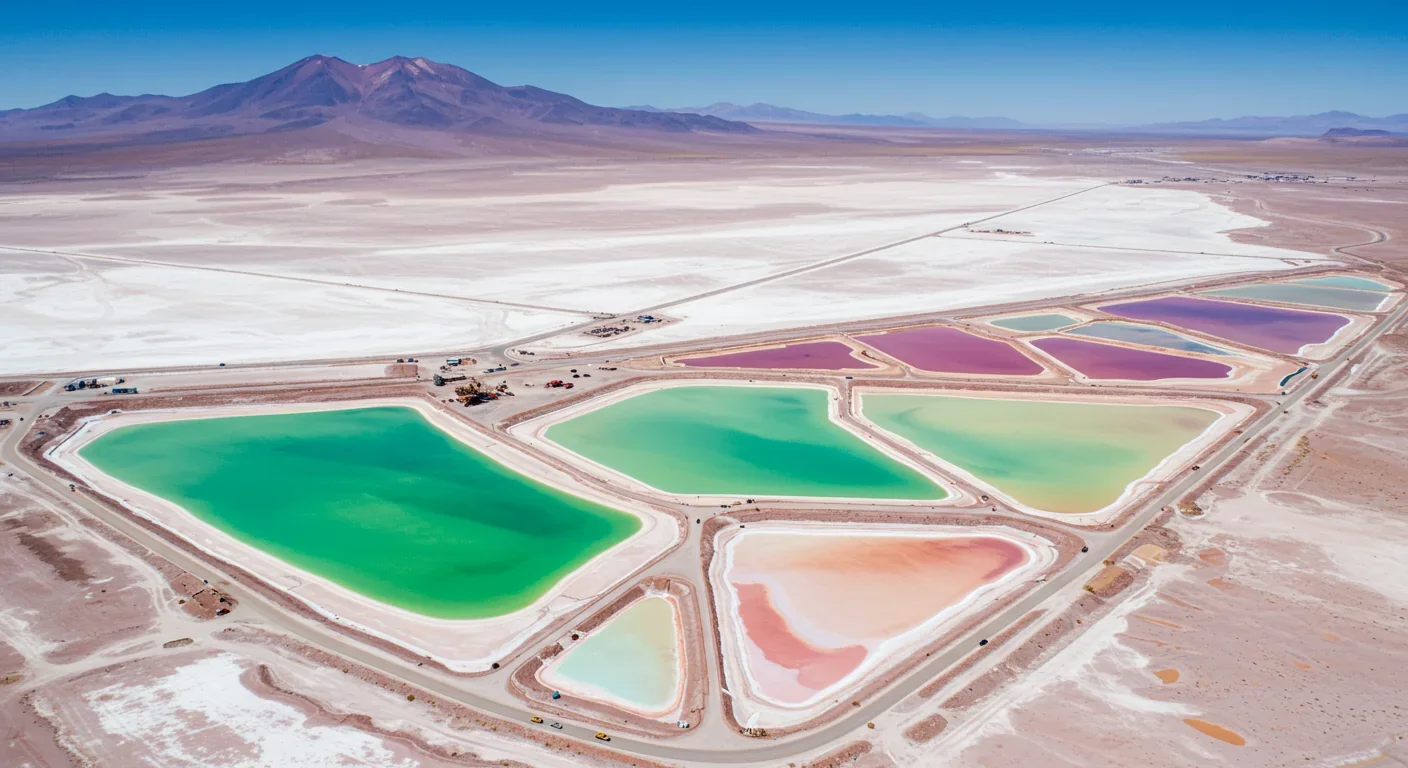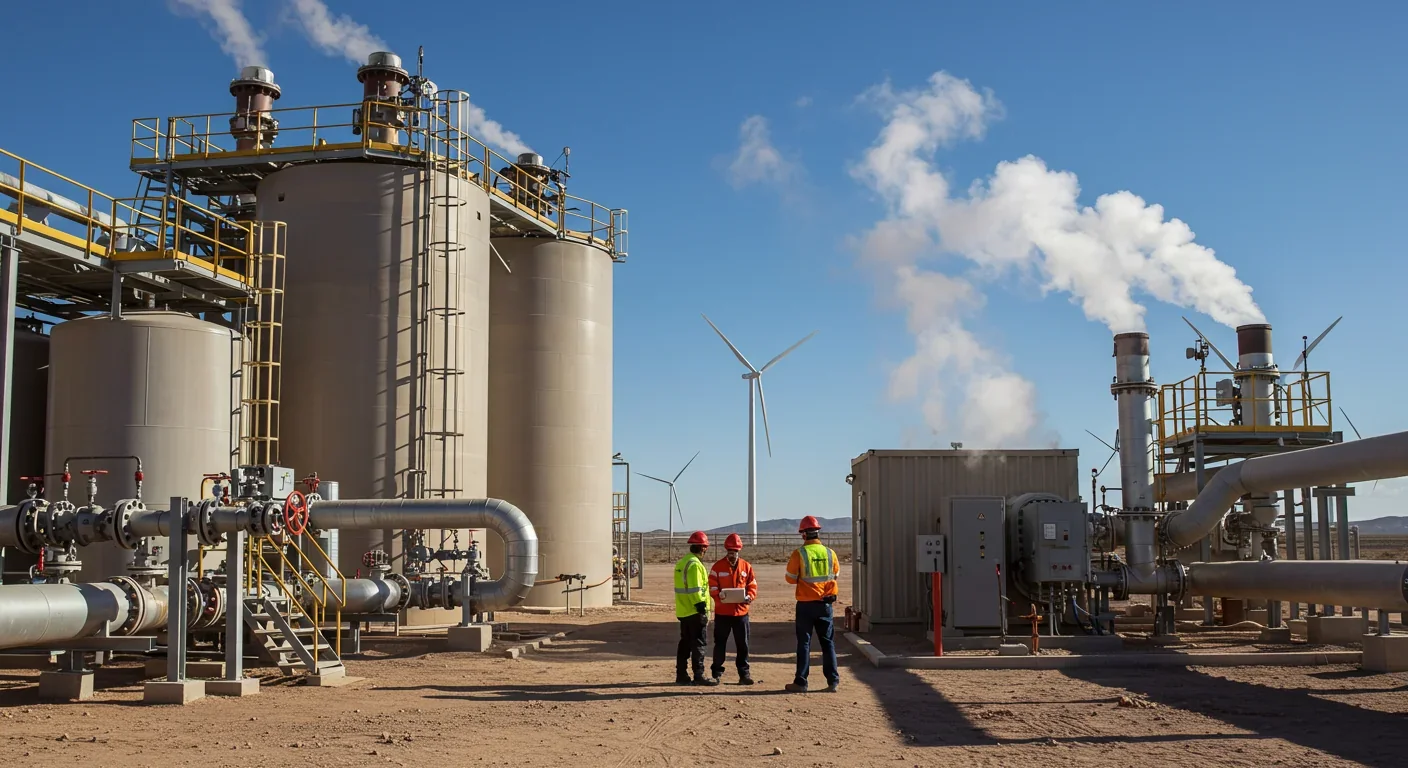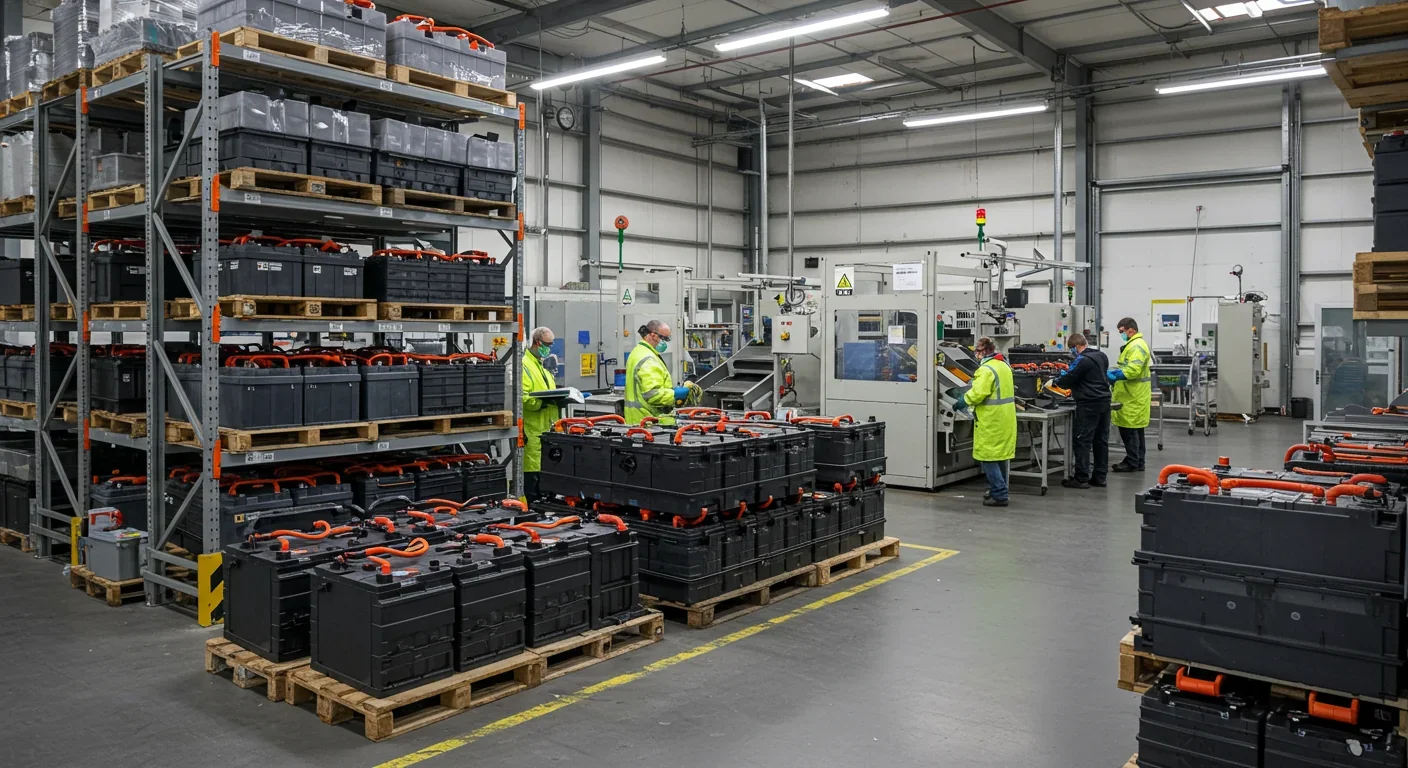Digital Pollution Tax: Can It Save Data Centers?

TL;DR: The global electric vehicle boom is driving unprecedented lithium demand, but extraction methods are draining fragile desert ecosystems. Chile's Atacama aquifers have dropped 10 meters in 15 years while new technologies like direct lithium extraction and battery recycling offer hope for more sustainable supply chains.

By 2030, the global electric vehicle fleet could exceed 150 million cars, each one powered by batteries demanding unprecedented amounts of lithium. But here's what most people don't know: producing just one ton of lithium carbonate requires evaporating half a million liters of water. In Chile's Atacama Desert, where some of the world's richest lithium deposits lie beneath ancient salt flats, groundwater levels have plummeted more than 10 meters in just 15 years. The clean energy revolution we're building on the surface is creating an environmental crisis underground.
We're living through a strange contradiction. The same batteries promising to save us from fossil fuels are draining some of Earth's most fragile ecosystems. Electric vehicles have become symbols of environmental responsibility, but the lithium inside them tells a different story.
The numbers are staggering. Global lithium demand is projected to grow sixfold by 2030, driven by both transportation and renewable energy storage. Yet current extraction methods haven't evolved much beyond industrial-scale evaporation, a process that takes months and consumes vast quantities of water in regions that can least afford to lose it.
In Bolivia's Uyuni Salt Flat, the world's largest lithium reserve sits beneath a landscape so pristine it's used to calibrate satellites. Indigenous communities have watched anxiously as their ancestral lands become the latest frontier in the battery rush. The promise of economic transformation clashes with fears of ecological devastation and cultural erasure.
Twenty years ago, lithium was a niche material used in ceramics and psychiatric medication. The smartphone revolution changed that, but it was electric vehicles that turned lithium into the oil of the 21st century.
The shift happened faster than anyone anticipated. Tesla's success proved EVs could be desirable, not just practical. Legacy automakers scrambled to catch up. Governments announced combustion engine phase-outs. Suddenly, securing lithium supplies became a matter of national security.
Energy giants entered the mining sector, bringing capital and urgency but not always environmental expertise. The result has been a gold rush mentality applied to a resource extraction process with profound ecological implications.
Chile, Argentina, and Bolivia form what's known as the "lithium triangle," holding roughly 60% of global reserves. But extracting that lithium comes at a cost that goes far beyond economics. In Chile's Salar de Atacama, the salt flat is sinking 1-2 centimeters annually as extraction pulls water from underground aquifers.
Walk through the Atacama and you'll see what lithium extraction actually looks like: massive evaporation ponds stretching to the horizon, their surfaces crystallized in unnatural shades of turquoise and white. These aren't natural features—they're industrial infrastructure operating on a geological timescale.
Traditional lithium extraction works through evaporation. Lithium-rich brine is pumped from underground aquifers into shallow ponds where, over 12-18 months, the sun concentrates the lithium enough for processing. It sounds simple, almost natural. It's anything but.
The water consumed doesn't just disappear from human use. In these desert ecosystems, every liter matters. Flamingo populations that have nested in these salt flats for millennia are declining as their feeding grounds dry up. Vegetation that stabilizes sand dunes withers. Communities that have farmed these harsh lands for generations watch their wells run dry.
Research shows that lithium mining in the Atacama consumes roughly 65% of the region's water supply. In an area that receives less than 20 millimeters of rainfall annually, that's not sustainable—it's suicidal for the ecosystem.
But water isn't the only casualty. Mining operations fragment habitats, creating barriers for wildlife movement. Dust from processing facilities coats vegetation for kilometers downwind. Chemical spills, while rare, can contaminate water sources for years. And unlike oil spills that eventually degrade, lithium contamination is essentially permanent.

Not all lithium comes from evaporation ponds. In Australia, the world's largest lithium producer, most extraction happens through hard rock mining of spodumene ore. This method is faster and doesn't directly drain aquifers, but it brings its own set of environmental challenges.
Hard rock mining requires blasting, crushing, and processing massive quantities of ore. For every ton of lithium produced, roughly 250 tons of rock must be excavated and processed. The energy requirements are enormous. The landscape impacts are immediate and dramatic—open pits, waste rock dumps, and tailings facilities that can leak for decades.
Australia's lithium operations have transformed forested hillsides into industrial moonscapes. Dust pollution affects neighboring communities. Noise from operations runs 24/7. And while companies promise rehabilitation, restoring native ecosystems can take generations, if it's possible at all.
Neither method is clearly "better." They represent different trade-offs, different ways of transferring environmental costs from one place to another.
The industry knows it has a problem, and technology is beginning to provide answers. Direct lithium extraction (DLE) technologies promise to revolutionize how we obtain this critical mineral.
Unlike evaporation, DLE uses chemical processes to extract lithium directly from brine, returning the remaining water to underground aquifers. The process takes days instead of months, requires far less land, and can reduce water consumption by 90% or more. Companies like Albemarle are piloting DLE systems in Chile, attempting to prove the technology at commercial scale.
But DLE isn't a silver bullet. Each brine deposit has unique chemistry, requiring customized extraction systems. The technology is expensive and energy-intensive. And critically, it's unproven at the massive scale needed to meet global demand.
Lithium recycling offers another path forward. EV batteries contain significant lithium that could be recovered and reused. Current recycling rates hover around 5%, but new technologies could push that above 90%. If we could recycle most lithium from end-of-life batteries, we'd dramatically reduce the need for new extraction.
The challenge is building recycling infrastructure before the first wave of EV batteries reaches end-of-life around 2030. Right now, recycling often costs more than mining fresh lithium. Market dynamics need to shift, possibly through regulation or subsidies, to make recycling economically competitive.
Governments face an impossible balancing act. They want to encourage EV adoption to meet climate goals, but they're increasingly aware of the environmental costs of battery production.
The European Union is leading on lithium extraction standards, requiring companies to demonstrate sustainable water management and community consent. The U.S. is investing heavily in domestic lithium production, hoping to reduce dependence on imports while applying stricter environmental standards than those common in South America.
In California, lithium extraction from geothermal brines in the Salton Sea region could provide a domestic supply with lower environmental impact. The federal government committed $95 million to develop this resource, recognizing both economic and environmental benefits. But even here, environmental justice concerns arise as marginalized communities question who benefits from extraction happening in their backyard.
Chile is debating nationalizing its lithium resources, following Bolivia's model. The goal is ensuring profits benefit citizens while imposing stricter environmental protections. But government-run mining operations haven't always proven more sustainable than private ones. The real challenge isn't ownership—it's enforcement.
Indigenous communities are demanding a seat at the decision-making table. In Bolivia, the Uyuni Salt Flat extraction plans have triggered political upheaval as communities reject development models that exclude their voices and threaten sacred landscapes.
This isn't just an environmental issue—it's geopolitical. China processes roughly 70% of global lithium, giving it enormous leverage over the EV supply chain. Western nations are scrambling to develop alternative sources, viewing lithium security as crucial to economic competitiveness and national security.
But the rush to secure supplies risks repeating historical patterns of resource colonialism. Rich countries want lithium for their clean energy transitions while exporting environmental damage to poorer nations. It's climate action built on environmental injustice.
Market analysis shows lithium hydroxide demand will reach $5.4 billion by 2030, with most growth in Asia and Europe. The economic incentives to extract lithium as quickly and cheaply as possible are enormous. Without strong international standards, we'll see a race to the bottom where environmental protections are sacrificed for market share.
Some analysts warn of a lithium shortage that could constrain EV growth through 2029. But the real shortage isn't in lithium reserves—it's in our ability to extract lithium sustainably at the scale required.

We stand at a crossroads. One path leads to rapid lithium extraction using current methods, accepting environmental damage as the price of climate action. The other path demands we slow down, invest in better technologies, and build supply chains that don't sacrifice ecosystems for batteries.
That slower path isn't painless. It means higher battery costs, at least initially. Slower EV adoption. Continued fossil fuel use while we develop sustainable alternatives. These aren't easy trade-offs.
But the fast path has costs too, ones we're only beginning to understand. Depleted aquifers don't refill on human timescales. Lost biodiversity doesn't regenerate. Communities displaced or damaged by extraction carry those scars for generations.
Effective market research suggests circular economy approaches could reduce lithium demand by 30-40% through better recycling and battery design. Longer-lasting batteries, standardized designs for easier recycling, and alternatives like sodium-ion batteries for some applications could all reduce pressure on lithium supplies.
Companies are beginning to respond to consumer pressure. Battery manufacturers are publishing supply chain sustainability reports. Automakers are investing in recycling infrastructure. Some are exploring alternative battery chemistries that reduce or eliminate lithium requirements.
Individual choices matter, but systemic change matters more. If you're buying an EV, ask about battery sourcing and the company's recycling programs. Support policies requiring supply chain transparency and environmental standards for battery production.
Advocate for public transportation and urban planning that reduces car dependence entirely. The greenest car is the one you don't need to own. Push for right-to-repair laws that extend battery lifespans and make recycling easier.
Support indigenous rights and environmental protections in lithium-producing regions. International pressure can influence corporate behavior and government policy. What happens in Chile's salt flats affects climate action everywhere.
Most importantly, demand honesty about environmental trade-offs. Clean energy isn't free. Sustainability requires acknowledging costs, not hiding them behind marketing claims about green technology.
The lithium crisis reveals a fundamental tension in environmental policy: solutions to one problem can create others. We're learning, sometimes painfully, that there are no simple answers to complex challenges like climate change.
But this crisis also shows our capacity to innovate when we must. DLE technologies that seemed impossible a decade ago are now entering commercial use. Recycling systems are improving rapidly. Alternative battery chemistries are advancing. We're not trapped by current extraction methods—we're choosing them through policy, investment, and consumer decisions.
The question is whether we'll change course before the damage becomes irreversible. Chile's aquifers won't wait for market forces to eventually favor sustainability. Bolivia's ecosystems can't pause while we figure out better extraction methods. Indigenous communities shouldn't have to choose between poverty and cultural erasure.
We have the knowledge to do better. We're developing the technology to do better. What we need now is the political will to prioritize long-term sustainability over short-term supply security. The batteries powering our clean energy future should be built on practices that don't undermine that very future.
This is the challenge of our time: building a sustainable civilization while undoing the damage of an unsustainable one. The lithium crisis is a test case. How we respond will determine not just the future of EV batteries, but our ability to manage the complex trade-offs inherent in any real sustainability transition.
The clock is running. The groundwater is dropping. And the decisions we make today will echo through the ecosystems and communities affected by our choice to power progress with lithium.

Recent breakthroughs in fusion technology—including 351,000-gauss magnetic fields, AI-driven plasma diagnostics, and net energy gain at the National Ignition Facility—are transforming fusion propulsion from science fiction to engineering frontier. Scientists now have a realistic pathway to accelerate spacecraft to 10% of light speed, enabling a 43-year journey to Alpha Centauri. While challenges remain in miniaturization, neutron management, and sustained operation, the physics barriers have ...

Epigenetic clocks measure DNA methylation patterns to calculate biological age, which predicts disease risk up to 30 years before symptoms appear. Landmark studies show that accelerated epigenetic aging forecasts cardiovascular disease, diabetes, and neurodegeneration with remarkable accuracy. Lifestyle interventions—Mediterranean diet, structured exercise, quality sleep, stress management—can measurably reverse biological aging, reducing epigenetic age by 1-2 years within months. Commercial ...

Data centers consumed 415 terawatt-hours of electricity in 2024 and will nearly double that by 2030, driven by AI's insatiable energy appetite. Despite tech giants' renewable pledges, actual emissions are up to 662% higher than reported due to accounting loopholes. A digital pollution tax—similar to Europe's carbon border tariff—could finally force the industry to invest in efficiency technologies like liquid cooling, waste heat recovery, and time-matched renewable power, transforming volunta...

Humans are hardwired to see invisible agents—gods, ghosts, conspiracies—thanks to the Hyperactive Agency Detection Device (HADD), an evolutionary survival mechanism that favored false alarms over fatal misses. This cognitive bias, rooted in brain regions like the temporoparietal junction and medial prefrontal cortex, generates religious beliefs, animistic worldviews, and conspiracy theories across all cultures. Understanding HADD doesn't eliminate belief, but it helps us recognize when our pa...

The bombardier beetle has perfected a chemical defense system that human engineers are still trying to replicate: a two-chamber micro-combustion engine that mixes hydroquinone and hydrogen peroxide to create explosive 100°C sprays at up to 500 pulses per second, aimed with 270-degree precision. This tiny insect's biochemical marvel is inspiring revolutionary technologies in aerospace propulsion, pharmaceutical delivery, and fire suppression. By 2030, beetle-inspired systems could position sat...

The U.S. faces a catastrophic care worker shortage driven by poverty-level wages, overwhelming burnout, and systemic undervaluation. With 99% of nursing homes hiring and 9.7 million openings projected by 2034, the crisis threatens patient safety, family stability, and economic productivity. Evidence-based solutions—wage reforms, streamlined training, technology integration, and policy enforcement—exist and work, but require sustained political will and cultural recognition that caregiving is ...

Every major AI model was trained on copyrighted text scraped without permission, triggering billion-dollar lawsuits and forcing a reckoning between innovation and creator rights. The future depends on finding balance between transformative AI development and fair compensation for the people whose work fuels it.